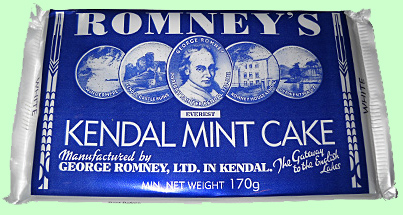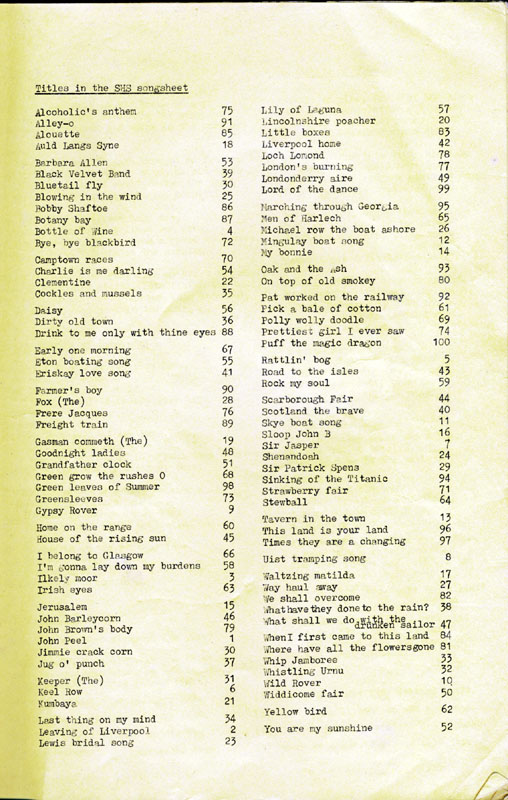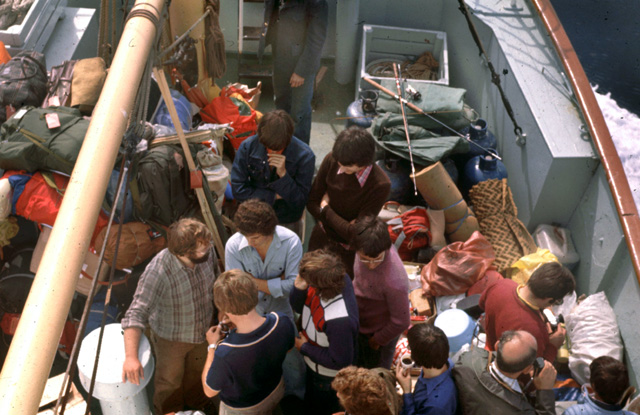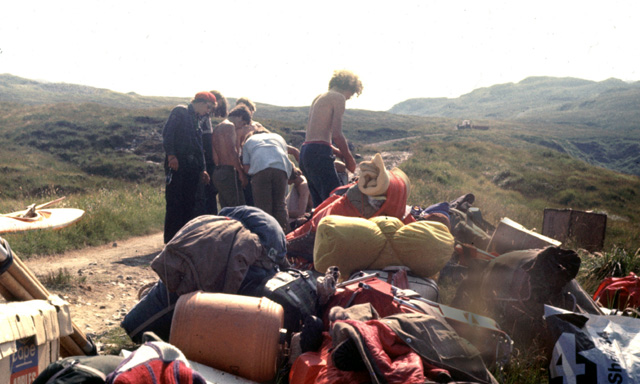![]()
![]()
A brief history of the S.H.S.... (and more)
The
S.H.S was set up by
John Abbott
with the first expedition in 1962 to Gometra, a small island off the coast of
Mull in the Inner Hebrides. Since that first trip until its demise in the
1980's, the S.H.S ran up to 6 trips a year during July and August. Each expedition
was for a given age range, from 12 to 17's and over and they visited a range of
islands in both the Inner and Outer Hebrides. Each expedition had a leader and
camp administrator together with a number of 'officers' and approximately 30
young people selected from applicants throughout the UK. The officers usually
had some expertise in a range of disciplines -ornithology, rock climbing,
canoeing, sailing, entomology, botany, and where possible someone with some
medical background. Often the leader and supervising officers were school
teachers, PhD students, post graduates, graduates etc.
The expeditions, where possible, carried out work for the local community such
as peat cutting,
bringing in hay, mending stone walls, tree planting etc, as well as with some
kind of project work
for our own benefit. This would be on a range of subjects, soil erosion, settlement,
hydrographic or shoreline litter surveys, botany projects and
archaeology to name a few. Add to this plenty of time messing about in canoes or
the rubber dinghy, fishing, bird watching, walking, rock climbing, sailing and swimming if
you could stand the temperature of the water, and generally having a good time.
Most people managed a bivouac away from camp for at least one night, taking a
small tent and food from the main camp.
Safety was
always an issue and bearing in mind this was long before mobile phones were in
use (the first truly mobile phone was
launched in 1983 in the US with a price tag of $3,995 and just half an hour of
talk time) so there was no quick way to summon help in the advent of an
accident or illness. During my time at least, there were measures in place to
try to reduce risks and cope with potential emergencies. Any party leaving the
campsite had to fill in an itinerary showing proposed routes, names of people
going, estimated time of return etc. There were first aid kits available and
each party had to carry one with them along with a map, whistle, compass and emergency
rations (usually Kendal Mint Cake, loved by some, hated by others!)
It was an early example of risk assessment and Health and Safety, but considering the remoteness of the locations and the difficult terrain it was completely necessary and I don't recall anyone thinking it was over the top or unnecessary? It was probably this though, more than anything else, that lead to the demise of the organisation. The idea of being responsible for up to 30 young teens on a remote Scottish island, engaging in activities like rock climbing, sailing or hill walking was, by the early 1980's probably a responsibility too far.
There were emergencies and accidents, not all S.H.S related though, like the time in Rhenigidale when villager Angus Campbell had to be carried to the boat on a rough night to transport him to hospital in Stornoway. But some were, suspected cases of appendicitis, even meningitis and a couple of accidents, one being a climbing accident and another a broken leg I think, the things people do to get a ride in a big yellow Sea King helicopter!
The trips weren't free of course, the cost of organising these expeditions must have been substantial and quite how you go about costing it all out and the logistics of getting everything in place, I'm not sure, but it is a tribute to those in the organisation who managed to do it and obviously do it reasonably successfully as there were probably in excess of 100 expeditions. I don't remember what they cost, and to be honest the figures would seem meaningless now anyway without some references to other items, but I don't remember it being expensive, quite the opposite I think.
Hopefully someone responsible for organising these expeditions will see this and maybe add some detail as to how it was all coordinated and costed out. There was the marquee (Black's of Greenock I seem to recall) and often a smaller one for stores, the 6 man tents and of course the 'bog' tents - not a reference to the terrain for which they are suited but their usage. (There's not a lot of acoustic insulation in a canvas toilet tent so it wasn't uncommon to hear tuneless humming and whistling coming from them, just to warn others they were occupied!) In terms of equipment, the water craft must have been the bulkiest to transport, a sailing dinghy, inflatable rubber dinghy and at least one (Seagull) outboard motor and usually at least 3 canoes. And then there was the kitchen equipment, large pots and pans, gas burners and gas bottles, kitchen utensils (did we take our own eating utensils and plates?) buckets, bowls and water containers and finally (assuming I've not forgotten anything) the food. Sufficient (usually) food for up to 40 people for a minimum of 2 weeks. Some of this could be sourced on the island, but someone would have needed to find out what would be available and how to get it to the campsite. I don't think the food could ever be classed as haute cuisine but it was certainly adequate [ See the camp administrator's delicious recipes for Rice Pilaf and Spam aux champignons in the 1975 S.H.S report pages 26-27]. The 3 photos below from the 1976 Rhum trip show some of the piles of 'stuff' being transported.
12/04/2015
![]() Roger Butler
just sent me the SHS songbook contents page (this should bring back a few
memories!) I can't say I remember the songbook as such, a lot of the songs
listed were certainly ones I remember singing from the trips, and I wouldn't
have known the words without some prompt so I guess we had the booklets as well.
Some classic camp fire songs on here.
Roger Butler
just sent me the SHS songbook contents page (this should bring back a few
memories!) I can't say I remember the songbook as such, a lot of the songs
listed were certainly ones I remember singing from the trips, and I wouldn't
have known the words without some prompt so I guess we had the booklets as well.
Some classic camp fire songs on here.
|
Roger has the full songbook which I could post on here but obviously the song lyrics can now easily be found on the internet if you want to look them up. As Roger said in his e-mail to me, the words were often modified, usually towards the profane, and I'm sure some of those lyrics will drift back into your mind when you see the titles of the songs. Happy reading! The complete songbook is now uploaded or go to reports page |
 |
 |
 |
 |
| 1. Equipment on the foredeck of the boat to Rhum. | 2. Awaiting a tractor and trailer to collect the equipment | 3. Some of the food stores in the marquee. |